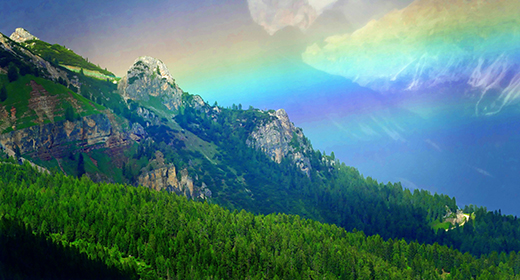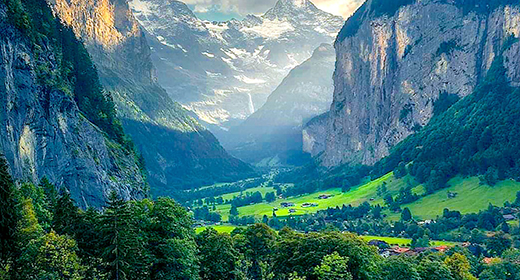by Meg Pier: Spiritual journeys have been around since antiquity, and mankind has felt the call to journey afar in search of meaning…
From those of the Abrahamic religions to Zoroastrians, as well as many who subscribe to no particular belief set, a time comes to cross their threshold on what they consider a pilgrimage.
Here, we dig deep into the concept of spiritual journeys, to learn more about our yearning for them. Is it the destination that calls to us, or something deeper?
“Evolution of modern transportation systems and the requirement to fit into work schedules have changed pilgrimage,” observed Dr. Justine Digance of Griffith University in Australia. “Few today would entertain a year-round trip from the U.K. to the Holy Land, which was the norm in the Middle Ages—along with all the hardships.”

“Many state that to be a pilgrim, one must encounter suffering,” she noted. “I don’t see that it has a role in today’s discussion of pilgrimage unless it is offered as part and parcel of the event, such as barefoot climbing of Crough Patrick in August is said to bring merit, as does certain pilgrimages done barefoot in both the Buddhist and Hindu traditions.”
Climbing Crough Patrick
A resident of Kenmare, Ireland, Des Dempsey, 41, said that people come from all over to climb Crough Patrick, or the Reek, as it is known locally.
“From Balintubber Abbey there is a traditional pilgrimage route across the fields and wild lands to the base of the mountain,” Dempsey said. “Reek Sunday is traditionally the last Sunday in August when thousands come and climb it, though generally not the locals. They will usually beat the crowds and climb it the Friday before.”

“The Reek is a difficult climb, involving some suffering, physically and mentally, often with harsh exposure to the elements and some sacrifice — of time, comfort, requiring endurance and strength, challenging a person physically, mentally and spiritually,” he continued. “When I did the climbs, I was considering the rewards, rather than the cost.”
“To walk such well-trodden pilgrimage routes are journeys worthwhile doing in themselves, but they make the arriving all the more rewarding,” he went on. “You become part of a bigger journey, something bigger than the self. As for climbing barefoot, it makes it a very different journey. You have to be so much more conscious of every step, to be in the moment and the attention you get is great.”
“People have been traveling that route on pilgrimage for generations untold, long before Christianity came to Ireland certainly,” he concluded. “Then they climbed it for Lugh of the Long Arm, the Sun God. When St. Patrick arrived, he climbed it too and declared it for the new Christian God and the Irish, ever accommodating, said “Grand,” and continued climbing. It’s a special place, immediately obvious to me the first time I ever saw it, regardless of in whose name it is climbed.”
Varanasi and the Cosmic Dance
Just as mountains have attracted those seeking spiritual heights, the confluences of big rivers are often places of powerful mythology according to Rana P. B. Singh, professor of cultural geography and heritage studies at Banaras Hindu University in Varanasi.
“The notion of Pudyadayi or ‘merit-giving’ refers to the inherent ‘spirit of place’ of a particular site, which since ancient times attracted sensitive and spiritual persons to come and get interconnected with the divine spirit as described in ancient texts,” he stated. “In the process of adding more representation from other religious places, and continuous superimposition of such mythic-mystic-sacrosanct images and rituals, the ‘merit-giving’ capacity of these places increased, expanded and attracted more people.”

According to Professor Singh, “Along the riverfront Ganga Ghats in Varanasi ‘life’ and ‘death’ both go together in the vision of Shiva’s cosmic dance. Shiva is the supreme and ultimate god of ‘life’ and ‘death’ together, and Varanasi is the resort of Shiva, that is how ‘life’ and ‘death’ are considered as two phases of life. The Ganga, being the liquid energy of Shiva, takes care of both the conditions: birth — life started in water, and death — final mergence is in the river.”
Spiritual Journeys to Holy Places
According to Tasoula Manaridis, 42, of Nicosia in Cyprus, it is the vestiges of spiritual leaders that make a locale sacred and beckon those seeking guidance and inspiration.
“In the Greek Orthodox faith a widespread and long-lasting custom is the journey to holy places to kneel in worship,” she said. “From antiquity and until present the conviction has persisted that prayer or the performance of religious duties are more effective in places where saints were born, died, wrought miracles, suffered martyrdom or merely existed; in ones where there were churches, relics of saints or miraculous icons. It is very common in the Orthodox religion that when someone faces a problem such as a serious illness to visit a place of worship, light a candle and pray for the well being of the ill.”
“Kykkos Monastery is one of those places,” she asserted. “The Monastery located in the Troodos Mountains is one of the richest monasteries on the island and it possesses one of the three icons of Virgin Mary ascribed by St Luke. Many pilgrims take day trips to the Monastery to pray and give an offering — it can be a piece of jewelry — to the Icon of Virgin Mary.”
The Hajj, a Tribute
For some pilgrims, the very journey itself is an offering.
According to a 75-year old Muslim and resident of the Republic of Djibouti in Africa who preferred to remain anonymous, “The Hajj is first of all an obligation for the believer. It is a tribute to God. The pilgrim does not go there to be cured or to receive something. As a result of it, one feels purified of all earthly blemishes, having made a sacrifice for his spirituality. Because it is a distant place, it is a financial challenge for many Muslims all over the world, especially as many are poor.”
“Being the most sacred place of Islam, a pilgrimage to Mecca is obviously a sacred journey,” he contined. “It is not, however, a tourist trip — it is forbidden to non-Muslims. According to tradition, the Kaaba was built by Abraham and Ismael. It is a house of prayer in the shape of a perfect cube. Their coming here is considered the first and founding pilgrimage. It is on this site that Abraham was willing to sacrifice his son Ismael, the father of the Arabs. Mecca is also the birthplace of the prophet Mohammed.”


“Mecca is the holiest and most sacred place in the world for Muslims,” said Sari Pitaloka, 46, of Jakarta. “More in particular, Masjid-il-Haram, the mosque where the Kaaba is located is the centre point to which the whole world community of Muslims physically, emotionally and spiritually directs their prayers, every single day, five times per day.”
“One of the qualifications to do Hajj is to be healthy mentally, physically and emotionally,” she continued. “Why would someone want to visit the house of the Creator if not in her/his best condition? The journey itself needs heath to support us to achieve the destination and to enjoy, get the best value of it.”
Buddhist Temples of Shikoku, Japan
Bob Davies, 65, of Durban, South Africa would likely agree. He considers pilgrimage visitation to a sacred place and made the route of 88 Buddhist temples on the island of Shikoku, Japan in 2005, a journey he said required stamina.
“I am generally extremely physically and mentally active, but walking so intensely for such a long period and distance naturally begs proper preparation,” he said. “That I undertook over the preceding three months in the local gym and a few long, backpack-laden hikes over the preceding weekends. As far as the joys and appeals of hiking are concerned, Shikoku per se is certainly not a preferred or recommendable destination.”
When asked if he would undertake the Shikoku pilgrimage again, Davies was uncertain.
“Maybe, if the need arises to experience certain aspects alluded to during the pilgrimage become singularly important to warrant deeper experience. Only spiritual need over the time ahead will tell,” he answered.

Spiritual Journeys | Inside or Out?
While for some, pilgrimage is a one-time event, for others it can represent a way of life.
“For me, a pilgrimage is a journey of the soul,” declared Ben Drake, 50, of New Forest, Hampshire in the United Kingdom. “There must be a destination or one never sets out, but that destination might be physical or spiritual. In my case, I attempted to make it both. I think I succeeded, I was certainly happy with what I got. Most Importantly it fitted with the greater pilgrimage of my life and nourished that.”
Drake conducted his pilgrimage on the occasion of his 50th birthday and faced a few fears in the process.
“I was inspired by the writings and example of Satish Kumar, a great pilgrim who undertook a walk around many of the spiritual places of Britain for his 50th,” Drake explained. “I wanted to mark a turning point in my life, a time when my soul and its wellbeing is the most important thing in my life.”

“I walked on my own, across the country just over 100 miles from the place that I am pleased to call home to a place that inspires me,” he said. “I attempted to be open, positive and loving with everyone and everything that I met — often my greatest challenge. I was challenged especially by two days of walking a 500-foot cliff top in thick fog, often disorientated and lost and also often in the grip of a fear of heights and of the unknown. There is a lot of unknown when you can only see 15 yards but you can hear the wind over the cliff top.”
“My view, based on many years studying the activity in Japan, is that pilgrimage is not just about one-off journeys out of the ordinary,” Ian Reader, professor of Japanese Studies at the University of Manchester in England observed. “It is a complex phenomenon in which a variety of apparently contradictory themes interact, and can co-exist without there being a real conflict. It is not a singular event; for many pilgrims, it is very much embedded in the structures of their daily lives as well. For some of the pilgrims I met in Japan, they went to Shikoku so regularly and spent so much time doing or preparing for pilgrimages that Shikoku became a sort of home for them and the pilgrimage became a normal part of their lives.
Outer Journey to Inner Destination
Tom Nowakowski, 40, is an avid long-distance hiker originally from Lodz, Poland, now of Palm Springs, California. He has traversed the Appalachian Mountain Trail, the Pyrenees, Swiss Alps, and just returned from hiking KommEmine across Bulgaria. Over four and a half months in 2007, he hiked the Pacific Crest Trail, a 2,650-mile journey stretching from Mexico to Canada.
The trek involved traversing 700 miles of Colorado and Mojave deserts and the snows of the Sierra Nevada Mountains.
“Pilgrimage to me it is a physical, outer journey to a spiritual, inner destination,” Nowakowski said. “Along thru-hike like the PCT is a perfect example of a pilgrimage. A journey where it is all about the going — not about what is at the end of the road. You walk for months at a time but there is nothing waiting for you at the end of the trail. Actually, when you get there it means that the trip is over – a very emotional experience for many. All that is truly important happens while you are journeying.”
“The hike is a chance to get rid of all the things you really don’t need, physically, mentally, emotionally,” he continued. “It is the art of deprivation. You are carrying your pack so you simplify. People often start the trail carrying everything but the kitchen sink and end up shipping a lot of stuff home. Water is very heavy so you walk from water source to water source. On the trail, the longest hike between water sources is 40 miles or two days.”
“You’re moving, your body is healthy and your mind goes quiet,” he recalled. “You’re mindful, aware — if you don’t pay attention, there will be a copperhead or rattlesnake, or you will slip on the trail. In spite of that, your mind doesn’t have over-stimulation of the everyday world, it empties. You start to digest things from far, far in the past, things have a chance to re-surface, it has a cleansing quality, a detoxifying effect.”
Nowakowski is not alone in finding that the open road leads to an open mind.
Spirituality in Everyday Life
Amanda Pressner, 32, is a co-author of “The Lost Girls: Three Friends. Four Continents. One Unconventional Detour Around the World.” The book is an account of a year-long backpacking adventure she and two friends embarked upon after quitting their high-pressure New York media jobs.
“Our journey was a pilgrimage, one that initially seemed to have no specific endpoint,” she said. “Unlike many religious pilgrimages, where a journey is made in order to worship at one specific place of great spiritual significance, we had no specific physical destination that we’d set out to reach.
“I was definitely awed by the devotion, its many forms, that I encountered in Southeast Asia,” she continued. “Religion and spirituality seemed to be infused into everyday life in places like Bali — with its ever-present offerings to the gods — and Myanmar — with its thousands upon thousands of stupas and temples. Faith was all around, rather than concentrated in a few very important sites where pilgrims might gather — you were reminded of that at nearly every turn.”

“We had some idea that the very act of leaving everything familiar behind, taking a leap, getting on the road—and being open-minded during our journey—would help us reach destinations of great emotional significance, and our hunch was correct,” Pressner concluded. “We eventually realized that our sacred endpoint was home and that we just had to go the long way around, and learn a lot about ourselves, in order to get there.”
Sometimes, the pilgrimage road can seem to extend forever, regardless of its length.
Argentina’s Pilgrimage of the Young
Fourteen years ago, Estani Puch, 36, made Argentina’s “Pilgrimage of the Young.” Held every October, thousands walk 65 kilometers from the barrio of Liniers in Buenos Aires to Luján, a journey that generally takes about 18 hours.
The Basilica of Luján is one of Argentina’s major places of pilgrimage. According to legend, in 1630, a tiny, terracotta statue being transported on an oxcart to Santiago del Estero, got stuck in the mud in Lujan. Nothing could make the cart budge until the statue was removed. It was taken as a sign that the 18-inch statue of the Virgin wanted to remain there.
Over time, a small shrine grew into one of Argentina’s major places of pilgrimage, now also known as “the Capital of Faith.”
“I was 22, and working in Wal-Mart at the time and trying to get a job in Citibank selling financial products,” Puch recalled. “This is back in 1996 when the unemployment rate was something like 17% in Argentina so it was really hard to get a decent job and hard to change jobs as well. So, while I was in the process of interviews, I promised that if I got the job, I would walk to Lujan.”
“I did the journey with a friend from work and with a Catholic congregation from Buenos Aires — there were around 150, 000 people walking,” he said. “You start walking at 8 a.m. and go all day and all night, till 3 or 4 in the morning. It is very tiring but if you stop it is impossible to start again. There is also support on the way — if you get tired or pass out they help you. Everything was organized — once you arrive at Lujan, there is a bus that brings you back to B.A.”

“Something funny about this walk is that the Basilica is quite tall, so you can see it from really far,” he continued. “That makes you think that you are getting really close, but it is still a long way to get there — you walk and walk and walk. Whoever you talk to will tell you they had the same impression.”
“The view of the church is what gives you faith to continue, but at the end you realize that what was important was the journey there or all the things in life that you have done,” Puch concluded. “I guess life is a pilgrimage and it is all about the journey, not the destination.”
Whether one considers pilgrimage to be a spiritual journey or a sacred destination, mankind has sought answers and enlightenment through movement since time immemorial. Be it a metaphor for life or a one-time occasion, pilgrimage is likely to be a feature of the landscape for some time to come.










































